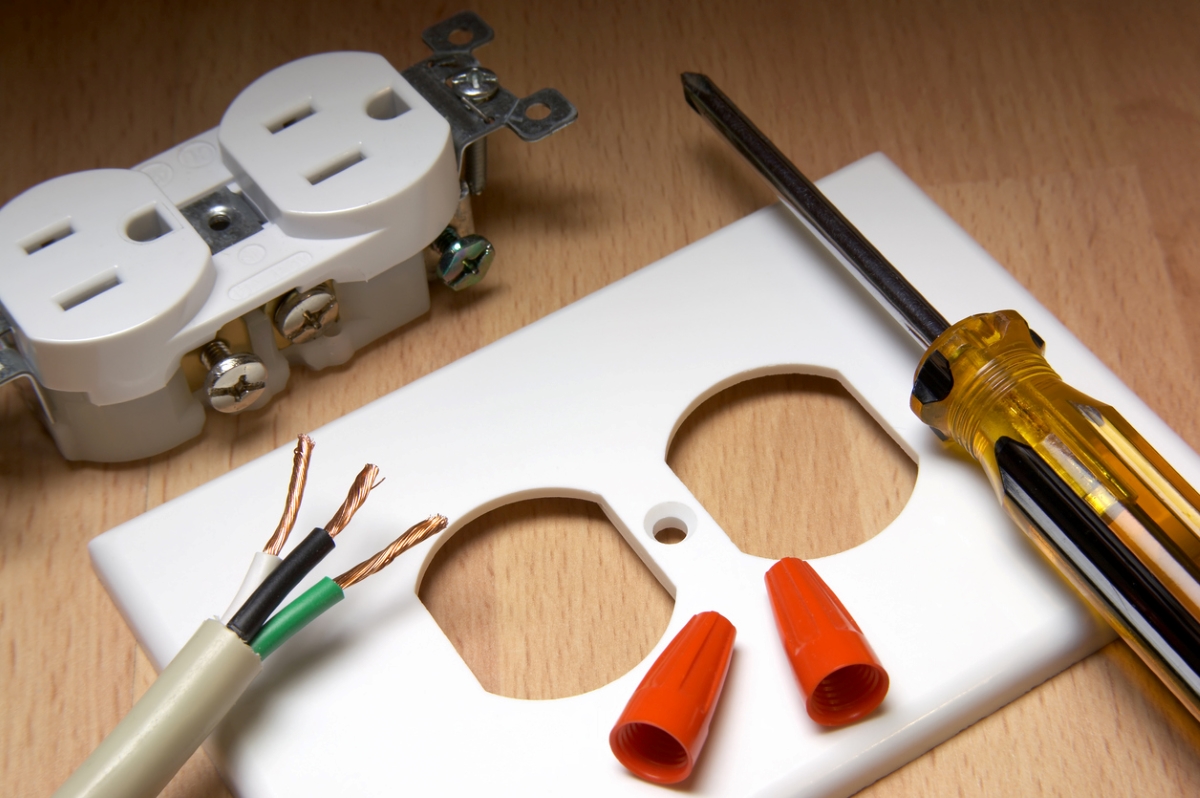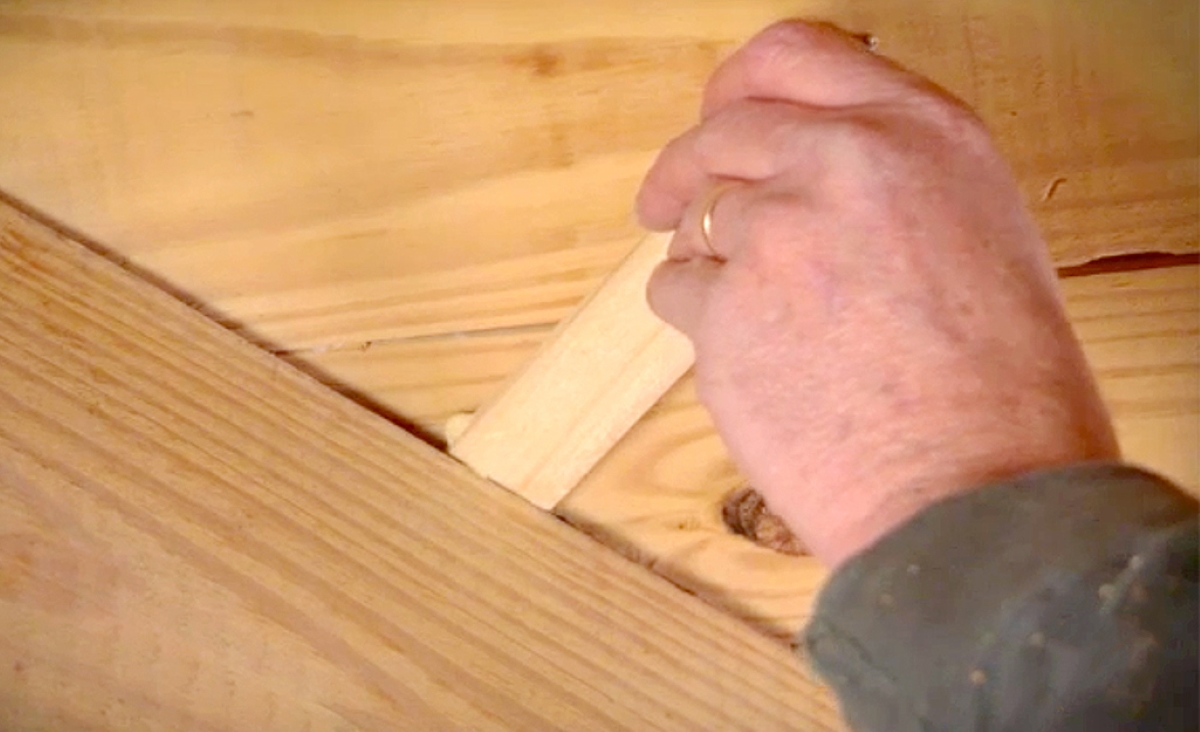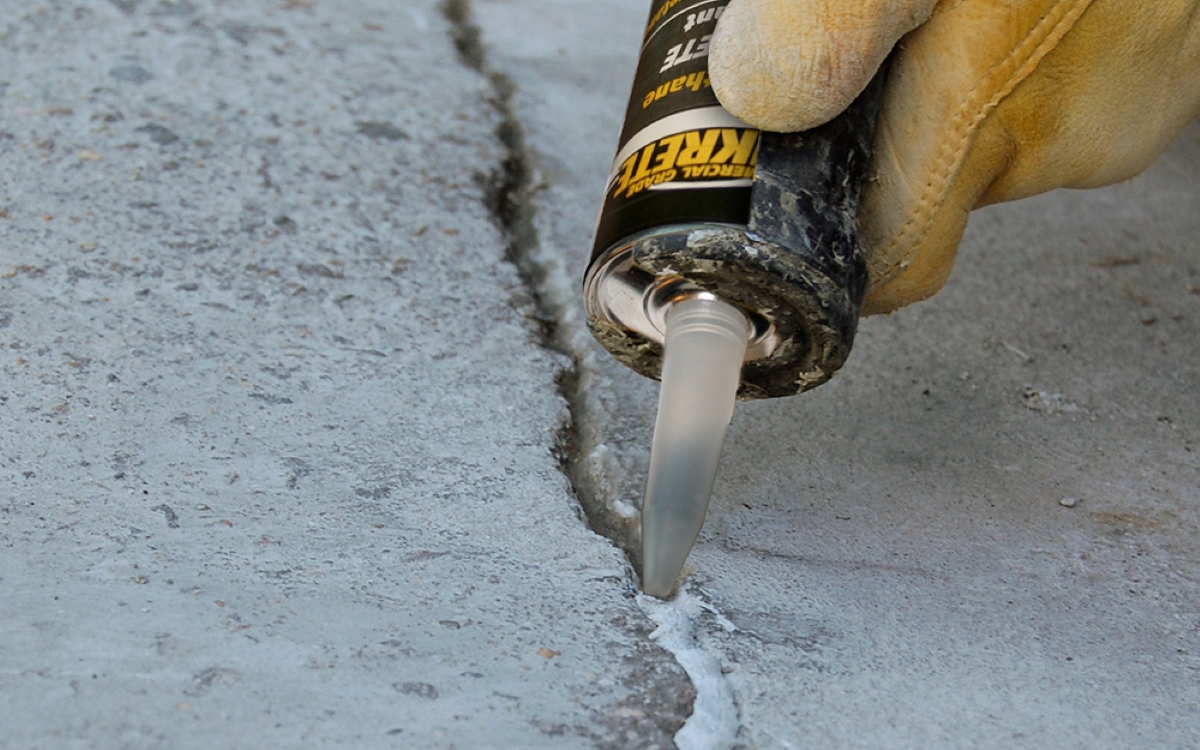We may earn revenue from the products available on this page and participate in affiliate programs. Learn More ›
Making small repairs from time to time is part and parcel of owning a home. While you can spend hundreds, or even thousands, each year to have a professional handle these odd jobs, tackling them on your own is a better option. Common repairs like fixing a clogged drain, changing out an old light fixture, and repairing a leaky faucet are relatively easy tasks that you can take care of on your own. Below are 25 easy repairs never to pay someone else for.
1. Silencing a Squeaky Door Hinge

No one likes a squeaky door. To silence yours once and for all, lubricate the hinge pin. Use pliers to pull out the pin, and then coat it in a thin layer of petroleum jelly, a nonstaining lubricant (alternatively, use the WD-40 Precision Pen to lubricate this tight space). Tap the pin back into place, wipe off any excess, and say goodbye to that creaky sound.
2. Replacing Aging Electrical Outlets

Here’s one fix everyone should know, because a broken electrical outlet now could lead to an electrical fire later! If an outlet is visibly cracked or your lamps flicker when you touch the cord, replace the outlet. Before you start, turn off the power to the outlet and use a voltage tester to ensure that electricity is not flowing. Then, simply swap out the old outlet for a new one, making sure first to check the wires for fraying and damage.
RELATED: Electrical Outlet Not Working? 8 Common Reasons Why and How to Fix Them
3. Repairing Holes in Drywall

It’s easy enough to damage a wall, but fixing it? Well, that can be slightly more difficult, but drywall patching rarely warrants a call to the contractor. Repairing small holes requires only spackling paste and touch-up paint. While larger holes demand a commensurately greater investment of time and materials, the fix remains within reach of average do-it-yourselfers. Our tutorial on how to patch drywall holes of all sizes provides step-by-step instructions.
4. Stopping a Running Toilet

Though it’s advanced by leaps and bounds internationally, toilet technology in the United States has changed little since the early 1900s. Yet, even though the mechanics are therefore straightforward, many people still consider a toilet’s inner workings to be somewhat mysterious. Commit yourself to a new familiarity with flappers, fill valves, and floats, however, and you may be surprised at how easy it is to fix a running toilet.
RELATED: 7 Clever Ways to Unclog a Toilet Without a Plunger
5. Troubleshooting Furnace Issues

If your furnace isn’t functioning properly, there are fixes to try before calling in the pros. Though it sounds obvious, make sure your thermostat is set to “heat.” Look over the furnace filter too, and check whether your thermostat needs new batteries. For even more easy fixes, refer to how to troubleshoot a furnace on the fritz.
RELATED: This Is How Often You Should Change Your Furnace Filter
6. Opening a Clogged Drain

The next time a clogged shower drain disrupts your morning routine, know that it’s not the end of the world. In fact, this is a fix you can address yourself for the cost of a plastic drain snake.
Pull out the drain stopper or strainer, and use the snake to drag out the gunk that’s stopping the water flow. If you have an old home with galvanized pipes, skip the snake, which can damage weak pipes. Instead, opt for a gentler method, such as pouring hot water down the drain to loosen blockages.
7. Unclogging the Garbage Disposal

The garbage disposal is handy for washing away small food scraps, but don’t treat it like a trash can. Dumping too much stuff at once or sending waste that’s too fibrous down the drain can clog the disposal. If this happens, use a broom handle (never your hands) to dislodge it.
RELATED: What to Do When Your Garbage Disposal Stops Working
8. Replacing Window Screens

A snag in a mesh window screen is an open invitation to outdoor pests, including spiders, stink bugs, and mice. But there’s no need to go out and buy a new screen, or even to call in a professional to repair it: Simply pull out the old screening, fit the frame with new material, roll in some new spline, and rest easy with your windows open once more.
RELATED: How to Replace a Window Screen
9. Lubricating Sticky Windows

If you live in an old home, chances are you’ve had to deal with your fair share of sticky windows. Because of changes in humidity and temperature, old windows can expand and warp over time, causing them to get stuck in the window frame. To fix a sticky window yourself, carefully use a hammer to drive a block of wood between the window and the track. Then, rub candle wax into the tracks to help keep the sashes sliding.
10. Clean Faucet Aerators

Not all water pressure problems can be fixed without the help of a plumber, but some are very easy to remedy yourself. For instance, if you’re experiencing low water pressure in a single sink faucet in your kitchen or bathroom, the problem is likely with the aerator, which controls the stream of water as it exits the faucet. Over time, minerals and other debris in your water can clog the aerator, slowing the flow of water. Fixing the problem is as simple as unscrewing the aerator from the end of the faucet, rinsing it out, and replacing it.
RELATED: After Filtering 50+ Gallons, Our Tests Show Faucet Water Filters Don’t Have To Be Expensive
11. Switching Out an Old Light Fixture

While working with your home’s electrical system may seem intimidating, there are certain wiring jobs you can safely handle yourself. Replacing an old light fixture is one of them. Start by shutting off electricity to the fixture at the electrical panel. Remove the old fixture by unscrewing it from the ceiling box and disconnecting the wiring. Attach the new fixture by connecting the ground wire to the ground connection in the box, and then connect white wire to white wire and black to black. Screw the new fixture into place and you’re done.
12. Fixing a Leaky Faucet

When you’re faced with a leaky faucet, your first instinct might be to call a plumber, but this repair is often one you can deal with yourself in about an hour with basic hand tools. The culprit is typically a faulty seat washer, which is the piece of rubber that ensures a watertight seal when you close the faucet valve. To fix a leaky faucet, shut off the water supply, remove the faucet handles, pull out the stem, and replace the seat washer with a new one.
RELATED: The Best Kitchen Faucets Tested in 2025
13. Replacing Old Caulk

Caulk plays a vital role in home maintenance by ensuring water doesn’t seep in between seams around the sinks, showers, and tubs in your kitchen and bathrooms. While caulk is made to be flexible and mold-resistant, it will eventually pull away from the hard surfaces around it and become stained with mildew. Replacing old caulk is a relatively simple job that involves removing the old caulk with a caulk removal tool, laying down a new bead of caulk using a caulk gun, and smoothing it with a finishing tool (or your finger).
14. Quieting a Squeaky Floor

Floors typically squeak because nails holding the subfloor to the joists fail, causing the wood to rub against the loose nail whenever someone walks over that section of floor. Assuming you’re comfortable navigating through your basement or crawl space to access the joist, fixing a squeaky floor is fairly easy. To make the repair, attach the subfloor to the joist using construction adhesive. If the subfloor has pulled away from the joist, use shims to bridge the gap.
15. Improve Central AC Airflow

If your air conditioner is blowing cold air but it’s barely coming out of the vents, you may be able to fix the problem without calling a pro. You will need to clear debris that’s blocking the flow of air from the AC unit to the ductwork.: Start by cleaning the condenser coils on the outdoor unit by rinsing them with a garden hose. Next, check the filters in the HVAC returns in your house. If you haven’t replaced the air filters in the past few months, they could be clogged with dust, choking your AC unit.
RELATED: These Are the 12 Best Things You Can Do for Your AC
16. Fill Driveway Cracks

Ignore cracks in your driveway at your peril. Left unchecked, they will spread and widen, eventually requiring an expensive professional repair or replacement. If you get to them early enough, you can repair those cracks yourself. For asphalt, treat tiny cracks with a tube of asphalt crack filler or repair the whole thing with a mop-on asphalt sealer. For concrete, use a concrete sealant or a concrete resurfacer.
RELATED: Testing the Best Concrete Sealers to Protect Against Stains
17. Repainting Walls

Painting interior rooms is perhaps the most common maintenance task that homeowners choose to take on themselves, and for good reason: All you need to conquer the job are a paint roller, a couple of brushes, and a few other basic painting tools. Begin by covering furniture and the floor with drop cloths to protect them from paint splatters. Use spackling or a wall repair patch kit to fix any damage to the surfaces. Sand the spackling once it dries before applying the fresh paint.
18. Swapping Out a Regular Light Switch for a Dimmer Switch

You don’t need to pay an electrician if you want to replace the old light switch in the dining room with a dimmer switch. First of all, be sure to purchase a three-way switch if the fixture is controlled by more than one switch.
After cutting off power to the switch at the electrical panel, use a flathead screwdriver to unscrew the light switch cover. Remove the screws holding the old switch to the outlet box and disconnect the wires. Install the new light switch, using the wiring diagram included with the switch as a guide.
19. Fixing a Fridge That Isn’t Cooling

If your food is spoiling before the expiration date, it’s possible that your fridge may not be keeping things cold enough. While the fix may require a repairman, you might be able to fix a refrigerator that isn’t cooling on your own.
Start by checking the thermostat settings to make sure they weren’t accidentally changed. Next, examine the door seals for damage. Inside the fridge, make sure the vents aren’t blocked by food. Finally, clear any dust and debris on the condenser coils on the back of the refrigerator to ensure the condenser is getting adequate airflow.
20. Patching Leaky Gutters

You don’t need to call in a professional to fix gutters that drip water every time it rains. This is an easy fix: Simply use a gutter sealant rated for outdoor use to plug any holes and cracks. While this will stop your gutters from leaking water, it’s just a temporary fix that might last a season or two. You’ll need to repair those damaged gutters sometime in the near future.
21. Reviving Dying Grass

That brown grass in your yard may look like it’s dead and gone, but that doesn’t mean it has actually expired. Before paying a lawn care company to fix or replace your dying lawn, attempt to resuscitate it yourself. Check first to see if the grass is truly dead by pulling up a fistful of it. If the grass holds to the ground, chances are the grass is just dormant. Nurture your lawn by watering it. Next, aerate the yard and add the proper fertilizer to give the roots the oxygen and nourishment that the grass needs to grow.
22. Repairing a Decaying Deck

You can extend the life of your deck by resealing it every few years, but eventually those deck boards may begin to splinter and rot. Before you spend a large chunk of money to replace your deck, consider repairing it. If the frame is in good shape, you may just need to trade out old deck boards. Use an impact driver to remove the screws on each damaged board. Then, cut new boards to match the dimensions of the old ones and secure them in place with new deck screws.
RELATED: How To Restore a Weathered Deck
23. Patching Ceiling Cracks

Most ceiling cracks are relatively easy fixes. If your ceiling is made of drywall, you can fix the crack by applying a thin layer of drywall compound over it. For plaster, cover the offending gap with a layer of new plaster. Once the drywall compound or plaster is dry, sand it and paint over it to blend it in with the rest of the ceiling. Large cracks or a bowed ceiling could be a sign of structural problems, in which case you’ll want to call in a professional as soon as possible.
24. Weatherproofing Drafty Windows and Doors

Rather than spending thousands on replacement windows or a new front door, shore up the existing windows and doors by installing weatherstripping tape. This inexpensive fix can have a big impact on your energy bill during the hottest and coldest months of the year. Because weatherstripping tape is just, well, tape, it’s very easy to install on your own. Apply the weatherstripping to door and window jambs to create a tight seal.
RELATED: Surprisingly, Our Favorite Window Insulation Isn’t the Thickest
25. Unclogging Leaky Pipes

A leaky faucet might be annoying, but a leak under the sink is even worse. It’s not uncommon for sediment to clog the P-trap, building pressure and causing leaks. Fortunately, you can easily fix a leaky P-trap without ever calling a plumber. First, place a bucket underneath the pipes to catch any trapped water. Next, loosen the nuts on the pipe and remove the P-trap. Dump out the sediment that’s settled and reattach the pipe. Now your sink should be leak-free!


